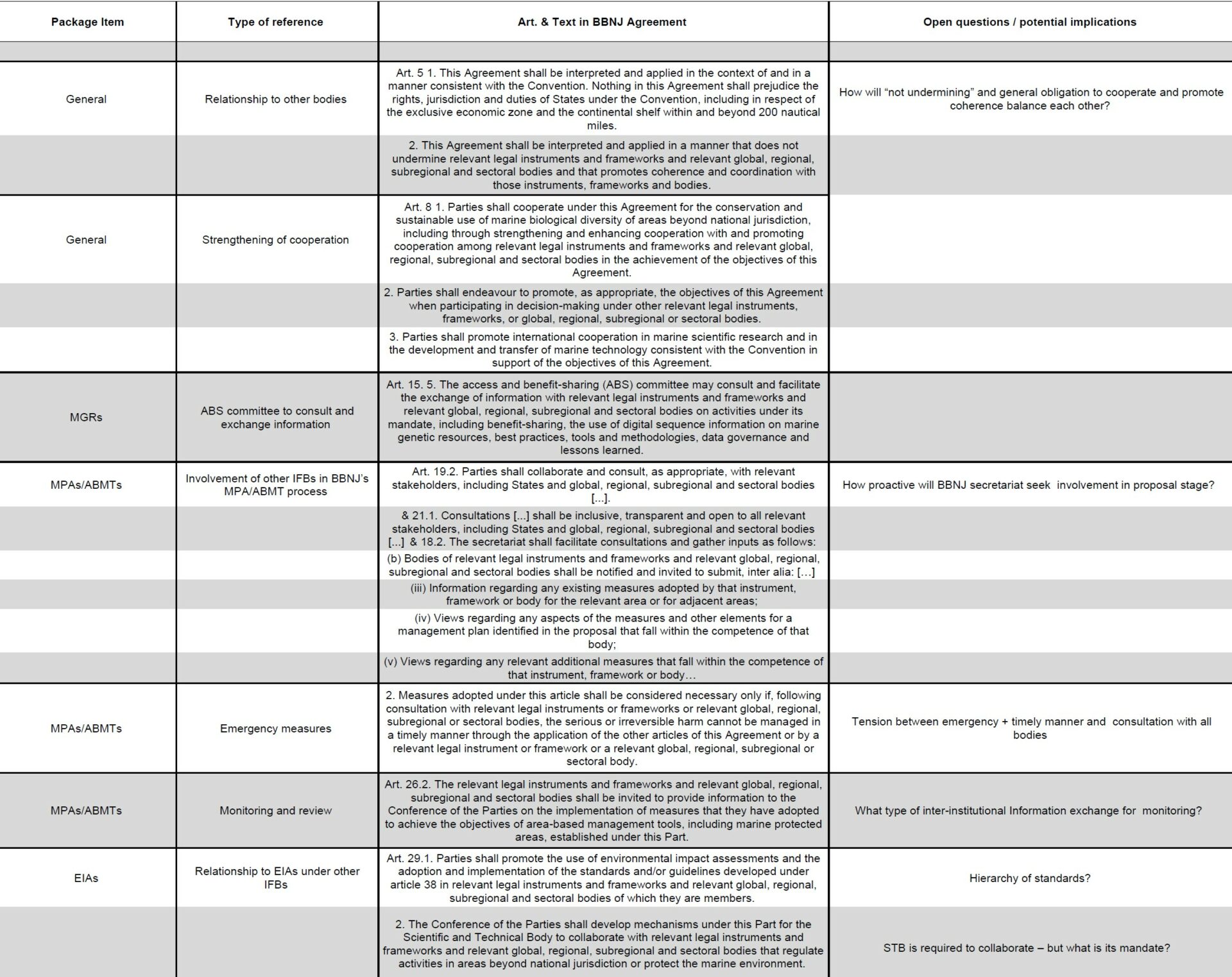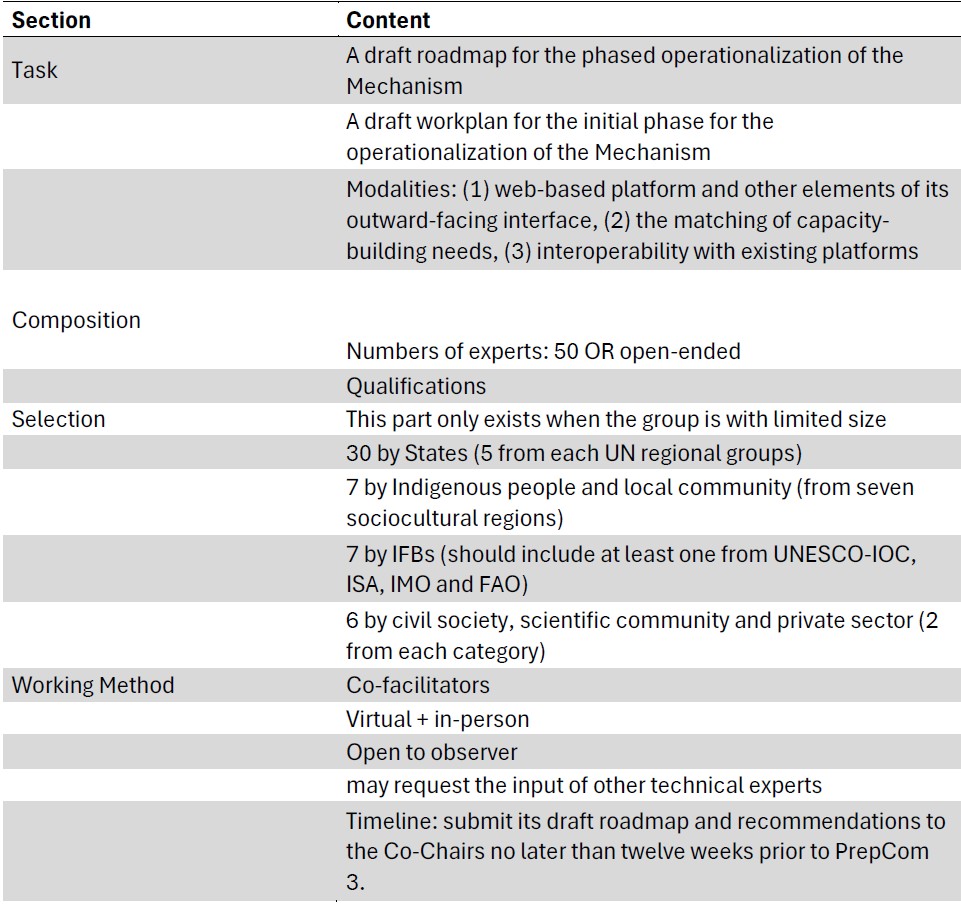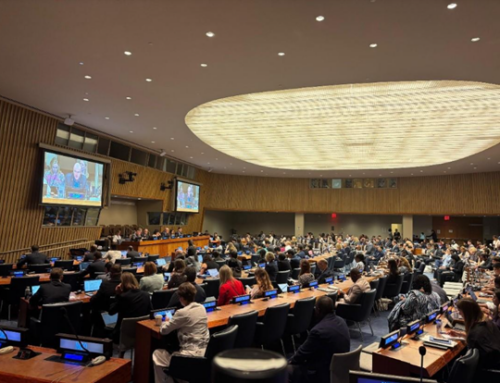From 18-29 August 2025, at the PrepCom2 in NY states will discuss how to implement the BBNJ Agreement. PrepCom2 will presumably be the last preparatory commission meeting before the Agreement’s entry into force. At the time of writing 52 states have ratified the BBNJ Agreement and a significant number – at least enough to bring the ratifications past the 60 which are required for the Agreement to enter into force – have announced to use the High-level Week around the General Assembly’s meeting in September 2025 to submit their ratification. If 60 ratifications are gathered by the end of September, 120 days later, i.e. by the end of December 2025, the BBNJ Agreement will enter into force. The days in which biodiversity in international waters is without legal protection may be over as soon as the new year’s fireworks and hangover fade. But is the institutional, technical and financial set-up ready to drive the operationalization of the BBNJ Agreement in a mere four months from now? This blogpost presents and discusses some of the documents that the UN Division for Ocean Affairs and the Law of the Sea (UNDOALOS) has published for delegates and observers in preparation of PrepCom2.
Written by Arne Langlet and Wenwen Lyu
This activity will be conducted as part of the Collaborative Event Ethnography (CEE) under the TwinPolitics project, led by Prof. Alice Vadrot and funded by the European Research Council. In addition to BBNJ, other venues of research include the International Negotiating Committee (INC) on a Plastic Treaty and the International Seabed Authority. Wenwen Lyu’s last blogpost on BBNJ covered the second week of the PrepCom1 negotiations in April 2025.
UNDOALOS as the interim secretariat for the BBNJ Agreement has made available a series of documents that aim to inform delegates and observers about the current draft of documents and the potential options outlining the key procedural and substantive topics to be addressed at PrepCom 2. These documents serve as basis for text-based negotiations or provide background information to prepare the groundwork for the implementation of the BBNJ Agreement. Based on these documents, negotiations will proceed with guiding questions provided by the co-chairs to allow delegates to engage in focused discussions and lay the foundation for faster progress toward text-based negotiations.
All documents are available online and include the following drafts for text-based negotiations:
- Revised aid to discussions and negotiations for the Rules of procedure for the Conference of the Parties (CoP) (A/AC.296/2025/12)
- Revised aid to discussions and negotiations for the financial rules governing the funding of the CoP (A/AC.296/2025/13)
- Revised aid to discussions and negotiations for arrangements with the Global Environment Facility (GEF) (A/AC.296/2025/14)
And the following notes and documents as background information on some key aspects for BBNJ implementation, namely:
- Draft terms of reference for an informal group on the technical aspects of the operationalization of the Clearing-House Mechanism (A/AC.296/2025/15)
- Note on arrangements to enhance cooperation with relevant legal instruments and frameworks and relevant global, regional, subregional and sectoral bodies (A/AC.296/2025/16)
- Note on reporting requirements in the BBNJ Agreement (A/AC.296/2025/17)
- Note on the operationalization of other provisions on financial resources and mechanism (A/AC.296/2025/18)
- Matrix on the terms of reference and modalities for the subsidiary bodies established under the Agreement (A/AC.296/2025/INF/3)
- Matrix on the possible options for the secretariat model (A/AC.296/2025/INF/4)
The blog post provides an in-depth analysis of four key documents: (1) the rules of procedure for the COP (A/AC.296/2025/12), which have been revised and significantly advanced based on discussions during PrepCom 1; (2-3) the arrangements to enhance cooperation with relevant legal instruments and frameworks and relevant global, regional, subregional and sectoral bodies (A/AC.296/2025/16) and reporting requirements (A/AC.296/2025/17), which were identified as key topics and features during PrepCom 2; (4) the draft terms of reference for an informal group on the CHM (A/AC.296/2025/15), which are expected to be finalized during PrepCom 2 so that the informal group can begin intersessional work. We also provided general comments on other documents.
Rules of Procedure of the CoP
On June 9th, UNDOALOS provided the new draft of the rules of procedure for the COP which builds on the collaborative discussions states had during PrepCom1 (See Wenwen Lyu’s blogpost from PrepCom1). Regarding the site of CoP meetings, states considered the secretariat’s seat or establishing a rotation of rotating host country – a choice between a possibly more economic or more inclusive option. Regarding the time, there was broad agreement to start with annual CoP meetings until the institutions are set up well and then move to a biannual rhythm.
There’s a clear balancing act in the current preparatory work between acting swiftly when needed while ensuring a broad and inclusive process which is particularly pronounced in Rule 3 of the CoP’s rules of procedure, especially in relation to Art. 24 of BBNJ on “Emergency Measures”. Accordingly, the new additions in the draft for the CoP’s rules of procedure reflect this by adding options for both in-person and virtual participation (Rule 3bis), as well as special provisions (Rule 3ter) for “Meetings on emergency measures”. The idea of having the possibility of online meetings is probably also informed by the experience of the COVID19 pandemic, in which formal negotiations were postponed—but informal dialogues continued through a mix of online initiatives. Reflecting on the possibilities and limits of online meetings, research conducted under the MARIPOLDATA project highlights that while broad consultations, webinars and informal discussions work well in virtual settings, critical formal sessions—in which key decisions are being taken—typically require states to be in the room (Vadrot et al., 2021). Still, particularly having in mind the necessity to discuss, consult and decide some issues in a timely manner and the costs, administrative burdens and inequalities related to organizing in-person meetings, states should seize the COP’s new provisions to hold preparatory and informal consultations virtually to maximize inclusivity, reduce logistical burdens, and maintain dialogue momentum.
The following table presents some key changes in the drafts for the CoP’s rules of procedure from PrepCom1 to PrepCom2:
Establish cooperative relationships with other IFBs
The document entitled “Arrangements to enhance cooperation with relevant legal instruments and frameworks and relevant global, regional, subregional and sectoral bodies” gives an overview about where and how the BBNJ Agreement addresses cooperation and consultation with other IFBs. It is in essence a commented summary of BBNJ’s references to other IFBs. The following Table is a tabular overview of BBNJ’s references to cooperation and consultation with IFBs to complement UNDOALOS’ preparatory document.
In summary, the Table above shows that the BBNJ instrument can and must function in cooperation, coordination and consultation with other IFBs in the broader marine biodiversity governance regime complex (which is not a new finding – see for example Arne Langlet and Simon Fellinger’s MARIPOLDATA blogpost on this issue, or for an attempt to estimate all potentially involved IFBs Langlet & Vadrot, 2023). Notably, UNDOALOS is undertaking important steps to start a cooperative, coordinative and consultative engagement with other IFBs (particularly remarkable considering UNDOALOS small (under)staffing for the current interim role) and has inquired a large list of IFBs for their input about their potential relationship with the BBNJ Agreement and their existing collaborative arrangements. Until now, 22 IFBs returned documents outlining their mandate and existing collaborative arrangements which are publicly available. In summary, although this compilation of documents is currently overwhelming as virtually all IFBs highlight their potential role and restate their mandate, this is a crucial first step to place the BBNJ institutions cooperatively within the existing governance framework and it shows a number of things. First, a more detailed and forward-looking analysis would be desirable – although politically sensitive – to envision and shape the future interactions between the BBNJ Agreement and the IFB at hand. Second, there are an impressive number of existing inter-institutional coordination and consultation frameworks within the UN and related IFBs, which suggests for the BBNJ Agreement to try to make use of the existing frameworks where possible. Third, the amount of submitted documents and the style of IFBs highlighting their potential contribution to BBNJ governance also indicates that there may be a certain amount of competition for tasks and mandates between IFBs at the moment (which coincides with scholarly expectations of IFB behavior in situations in which a regime complex is (re)shaped (Langlet & Vadrot, 2024).
Reporting requirements
Another helpful document published by UNDOALOS addresses the reporting requirements that states are facing when becoming a party to the BBNJ Agreement. This document not only summarizes the existing reporting requirements within the BBNJ text but importantly provides a summary of existing reporting requirements under other instruments. Under BBNJ, there are multiple obligations for States to report periodically on the implementation of different parts of the Agreement (Part II Art. 16(2) (monitoring and transparency in of activities with respect to MGRs), Part II Art. 26 (monitoring and review of MPAs/ABMTs), Part IV Art. 36(1) (reporting (on impact) on authorized activities after EIA), Part V Art. 45(3) (periodical monitoring of capacity-building) as well as on the overall implementation of the Agreement (Art 54)). The format and content of the foreseen reports typically to be submitted to CHM or Secretariat are still up to be defined by CoP and STB and the available documents suggest a strong attempt to streamline and harmonize with existing instruments. The secretariat’s note on reporting requirements shows that the practices of reporting under different IFBs (for example regarding format and intervals) are very diverse. The PrepCom and subsequently the first CoP now has the task to find the delicate balance between future-proofing the BBNJ instrument with “teeth”, ensuring compliance through regular reporting and placing unnecessary burden to Parties. It is therefore important to balance the frequency of reports and avoid unnecessary duplication. Submitting all reports through the Clearing House Mechanism may help in avoiding duplication as well as enhance transparency and efficiency. Literature in support of BBNJ’s implementation has also come up with flowcharts and explanations that outline the reporting requirements for states parties and the processes under the Agreement’s packages (See Langlet et al., 2025 or Kachelriess, 2023 for visualizations of reporting processes).
Draft ToR for informal group on CHM
Another key document is the draft ToR for an informal group on the technical aspects of operationalizing the CHM (A/AC.296/2025/15). Following discussions on the CHM during PrepCom 1, delegates requested two tasks to be delivered before PrepCom2: (1) developing a ToR for an informal group to work on the technical aspects of establishing the CHM, and (2) creating a flowchart outlining the CHM functions. The ToR has attracted particular attention, especially from developing countries, as it represents the first concrete step toward operationalizing the CHM, an essential foundation for ensuring that benefit-sharing and capacity-building measures are in place as soon as the treaty entries into force. The table below summarizes the content of the ToR:
It is worth noting that while the informal group is expected to work intersessionally before PrepCom 3, which will take place in New York next March, substantive work needs to be completed during PrepCom 2. Delegates face clear time pressure to agree on a final version of the ToR at PrepCom 2 so that the group can be established as soon as possible. According to the current proposed organization of work, negotiations on the CHM will begin on Wednesday of the first week, with nine hours allocated. Determination, flexibility, and prioritization from all delegations will be essential to achieving the goal of finalizing the ToR during PrepCom 2.
In terms of content, delegates still need to decide whether the group will be open-ended or limited in size. If it is to be limited, questions remain about how the group will be composed and what selection process will be used. Under the current draft, the 50 members would include 30 representatives from States (five from each UN regional group), 7 from Indigenous Peoples and local communities (one from each of the seven sociocultural regions), 7 from IFBs, and 6 from civil society, the scientific community, and the private sector. It is uncertain whether this composition will satisfy all parties. As always, the issue is highly political – balancing the need for representation from Small Island Developing States and Least Developed Countries, as well as ensuring geographical diversity, while avoiding technical duplication, is a delicate task. In addition, it is still unclear who, or which entity, will lead the selection process.
The financial rule and mechanisms, Secretariat, and Subsidiary Bodies: what’s next?
The financial rules were discussed at PrepCom 1 through text-based negotiations. Delegates highlighted that the rules will ultimately depend on the Secretariat model chosen. In addition, developing countries stressed the lack of documentation on the special fund, the voluntary fund, and their relationship with the GEF fund. The background document for the operationalization of other provisions on financial resources and mechanisms (A/AC.296/2025/18) has now been delivered. It will be important to allocate adequate time at PrepCom 2 to exchange views and move toward text-based negotiations. Discussions on the seat of the Secretariat and the Subsidiary Bodies are also proceeding, supported by two large matrices prepared by the Secretariat ahead of PrepCom 2. While the matrices provide extensive information, it remains important to transition to text-based negotiations as soon as possible—a step that ultimately lies in the hands of all delegations.
Conclusion
For the BBNJ Agreement to truly take off and begin its work, much still needs to be decided. The excitement surrounding its entry into force offers a rare opportunity for high seas conservation—but it also places a responsibility on states to deliver on its ambitious goals. This PrepCom has the potential to lay the foundation for the BBNJ bodies to operate efficiently from day one. The cooperative spirit at PrepCom1 was encouraging to witness, and it will be crucial to maintain that momentum as substantive decisions now come to the table.
The preparatory work by UNDOALOS as interim secretariat is equally encouraging, particularly in how they have provided detailed documents to help states come ready to engage—states must now make full use of them. Notably, UNDOALOS is working to streamline rules and reporting requirements with other international frameworks and bodies (IFBs), making future implementation easier for states. Their early consultations with IFBs, even before the BBNJ Agreement enters into force, acknowledge the complexity of the existing governance landscape while offering other bodies a chance to define their role within the BBNJ system. While the precise nature of these relationships will not be fully resolved at the PrepComs, setting a clear, cooperative path forward is essential.
If PrepCom2 succeeds in turning momentum and cooperative spirit into concrete arrangements and clear pathways for action, it will give the BBNJ Agreement the solid launch it needs to move from promise to practice.
Find Wenwen’s blog post on the previous BBNJ meeting here: https://twinpolitics.eu/setting-up-institutions-during-the-first-bbnj-prepcom-how-far-have-we-come-cloned/
Find our Ocean Data Survey here: Ocean Data Survey – Twin Politics
Find other blogs on conference participation here: Blog – Twin Politics








